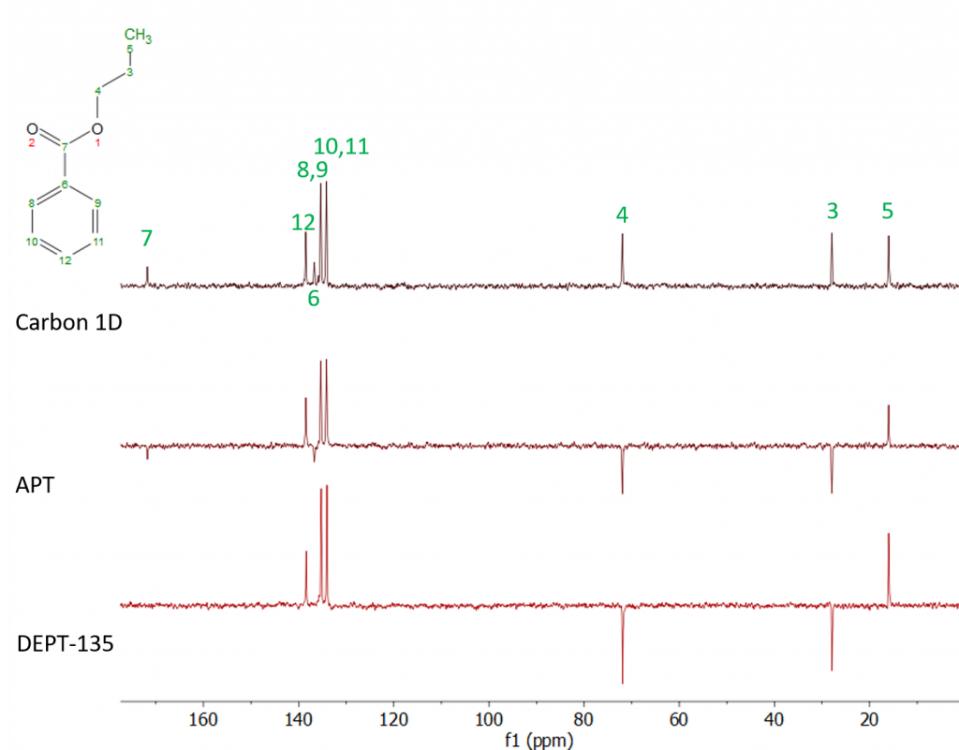DEPT and APT NMR Service
Distortionless enhancement of polarization transfer (DEPT) is a detection technique in carbon spectroscopy NMR spectroscopy. It can be used to determine the diversity of carbon atoms, i.e., whether they are primary (methyl or -CH3 group), secondary (methylene or -CH2 group), or tertiary (hypo methyl or -CH group). Three variants, DEPT-45, DEPT-90, and DEPT-135 NMR, are available.
DEPT NMR can be applied to identify compounds, especially for the designation and identification of some carbon signals with very complex structures containing different numbers of hydrogen atoms with simplicity and accuracy. DEPT NMR, although it cannot directly observe quaternary carbons (i.e., carbons without hydrogen), can accurately identify quaternary carbons in combination with the full map, and the DEPT map is clearer. It can overcome some difficulties in the overlapping of resonance lines in the partial resonance test and the fingerprinting of complex molecules. The measurement time is shorter than that of the partial resonance spectrum.
Features of DEPT NMR
- With high resolving power, the spectral lines are well separated from each other and easy to identify
- The large chemical shift range (0~300 ppm) is 20-30 times of NMR spectra
- Low natural abundance. It is not possible to have two 13C in one molecule at the same time, and it is not necessary to consider the coupling of 13C with 13C, only 1H-13C coupling.
- Accurate determination of the chirality time can be used as a spectroscopic parameter for the structural identification of compounds and help to designate carbon atoms
- Information on carbon atoms, especially when there is no H linkage, is available to determine the carbon atomic level
- Easy implementation of double resonance experiments
The attached proton test (APT) is a very useful experiment that, like DEPT, provides information on how many hydrogens or protons are attached to a particular carbon atom. Both DEPT and APT do this by "editing" the spectrum so that the carbon signal points up or down depending on the amount of hydrogen attached.
APT provides multiplicity information without losing the quaternary carbon signal, allowing you to collect only one spectrum instead of two, making it a useful alternative to DEPT in many cases.
 Figure 1. Comparison of conventional carbon, APT and DEPT-135 spectra of neat propyl benzoate. (Claridge, T. D. W., 2016)
Figure 1. Comparison of conventional carbon, APT and DEPT-135 spectra of neat propyl benzoate. (Claridge, T. D. W., 2016)
Comparison of DEPT NMR and APT NMR
- Quaternary carbons are retained in the APT spectrum, while they are not present in DEPT.
- Running two or more DEPT experiments can distinguish CH from CH3 more effectively than APT. But DEPT NMR cannot distinguish between the number of 1H nuclei attached to the carbon.
- DEPT uses something called polarization transport, while APT does not.
Both DEPT NMR and APT NMR are useful methods for structure resolution. DEPT-45, DEPT-90, and DEPT-135 together show the primary, secondary and tertiary carbons, but not the quaternary carbons. APT shows the primary, secondary, tertiary, and quaternary carbons, but does not distinguish between methyl and hypo methyl carbons as DEPT does.
Creative Biostructure will recommend the most reasonable and economical experimental solution for you according to your experimental purpose and needs, which is not a concern for you at all. Please feel free to contact us for the best solution for DEPT NMR and APT NMR.
Ordering Process
Reference
- Claridge, T. D. W. High-resolution NMR techniques in organic chemistry. Vol. 27. Elsevier. 2016.

